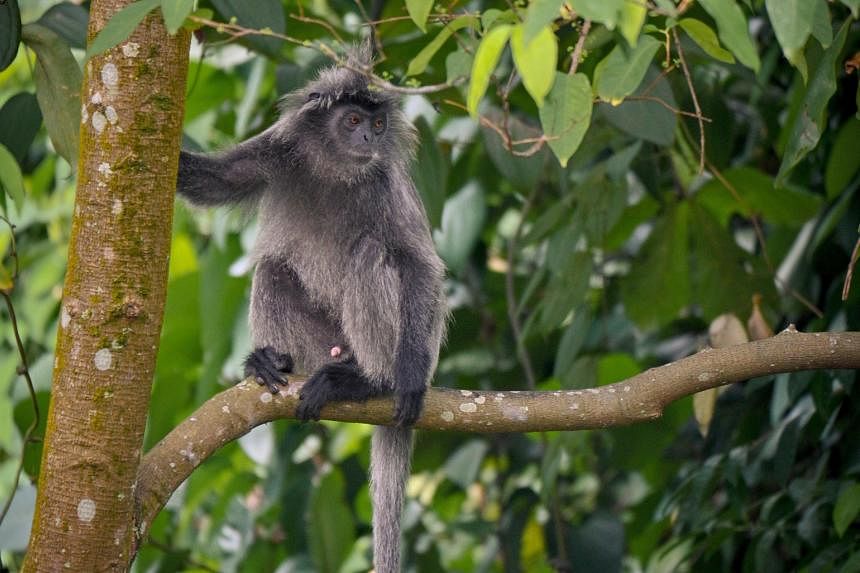
SINGAPORE – A stroll around campus for one student serendipitously led to an encounter with a silvered langur on Sept 5, marking the first reported sighting of the monkey here.
Prior to this, there have been no records of the species in Singapore, according to the National Parks Board (NParks).
Final-year National University of Singapore (NUS) student Tony Ng told The Straits Times that he was walking in Clementi Woods Park at about 4pm when noises that sounded like those made by wild boars piqued his interest.
To the 23-year-old’s surprise, the grunting sounds came from a monkey on a tree.
“At first, I thought it was a Raffles’ banded langur. When I searched on Google, I realised it looked nothing like it,” he said.
Singapore has two species of langur: The native Raffles’ banded langur and the dusky langur, which is naturally found in Peninsular Malaysia, Myanmar and Thailand.
The medical student snapped a few photographs of the male silvered langur, which was alone. When he left half an hour later, the animal was still on the tree.
“It was just zoning out… I was confused because it didn’t look like anything I had seen before,” said Mr Ng.
Primatologist Andie Ang said the leaf-eating monkey belongs to one of two species of silvered langur, which get their name from their shimmering grey fur under the sun.
The langur could either be Trachypithecus selangorensis native to the forests of West Malaysia or Trachypithecus cristatus found in Sumatra, Batam, Bintan and Borneo, added the head of primate conservation and Singapore programmes at Mandai Nature, the conservation arm of Mandai Wildlife Group.
It is improbable that this langur is an escaped pet since the monkey is an adult male that appears to be healthy, said Dr Ang, who also chairs the Raffles’ Banded Langur Working Group set up in 2016 to save the critically endangered local monkey.
“Silvered langurs are traded in the pet market, but usually these are their juveniles or orange-furred babies that do not do well under human care to survive until adulthood,” she said.
Embed Instagram
Instagram URL
Where Singapore's wild things are
NParks monitoring Jalan Besar ‘Mission: Impossible’ monkeys, herding them to forested areas
“It is also normal for male langurs to search for new groups, so it is not unusual to see an adult male moving alone.”
It is more likely that the monkey arrived as a stowaway on a ship or swam from Indonesia, she added.
“Silvered langurs are known to swim pretty well. How long they can swim, however, is not known,” said Dr Ang.
This week, Dr Ang and a team of citizen scientists from the Raffles’ Banded Langur Working Group will search for the langur and collect its faeces.
It was last seen on Sept 11 by several NUS students in Ridge View Residential College.
Dr Ang said: “As the silvered langur is non-native, we don’t know what consequences it will have on the local ecosystem. It’s even worse if it’s alone because langurs are social animals.
“If it manages to find its way to the Central Catchment Nature Reserve, it might even endanger native Raffles’ banded langurs as the silvered langur is generally larger in body size.”
Collecting the scat will provide vital clues for Dr Ang and her team through DNA sequencing.
The two species of silvered langur are virtually indistinguishable outwardly, so knowing the genetic identity of the langur would help scientists understand which location it came from, she said.
Mr How Choon Beng, NParks’ director of wildlife management and outreach, said the statutory board is aware of the sighting and will work with nature groups to monitor and assess the langur’s behaviour.
Monkey business at Punggol Settlement: Nuisance to restaurants, amusement to patrons
Meet the wildlife that call Singapore home
He said: “The silvered langur is generally shy, and is not likely to approach humans.
“Members of the public are advised not to approach or feed the animal.”
If the public encounters langurs, they should keep a respectful distance of at least 5m.
Flash photography should be avoided as it may scare the creatures.
Join ST’s WhatsApp Channel and get the latest news and must-reads.
p.st_telegram_boilerplate:before {
display: inline-block;
content: ” “;
border-radius: 6px;
height: 6px;
width: 6px;
background-color: #12239a;
margin-left: 0px;
margin-right: 13px;
}
a.st_boilerplate {
font-family: “SelaneWebSTForty”, Georgia, “Times New Roman”, Times, serif;
}